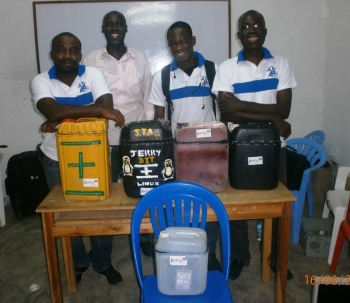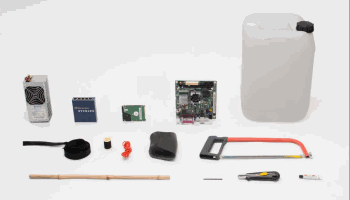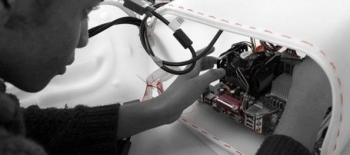- Building a 3D Digital Clock with ArduinoPosted 3 months ago
- Creating a controller for Minecraft with realistic body movements using ArduinoPosted 4 months ago
- Snowflake with ArduinoPosted 4 months ago
- Holographic Christmas TreePosted 5 months ago
- Segstick: Build Your Own Self-Balancing Vehicle in Just 2 Days with ArduinoPosted 5 months ago
- ZSWatch: An Open-Source Smartwatch Project Based on the Zephyr Operating SystemPosted 6 months ago
- What is IoT and which devices to usePosted 6 months ago
- Maker Faire Rome Unveils Thrilling “Padel Smash Future” Pavilion for Sports EnthusiastsPosted 7 months ago
- Make your curtains smartPosted 7 months ago
- Configuring an ESP8266 for Battery PowerPosted 7 months ago
Interview to Xavier Auffret, founder of Jerry Do It Together
Xavier Auffret is a former telecommunication engineer who decided to reorient his work toward industrial design in order to get closer to human consideration.
Xavier is now finishing his industrial design studies at ENSCI-Les Ateliers, in Paris.
He is the designer, together with two other designers of the first Jerry and co founded the non profit organization Jerry. Xavier is also co founder of a design studio in Paris, l’Atelier Universel, which bring together people with diverse trainings and skills.
Jerry it’s basically a computer that is easy to make with second hand materials. Xavier told us that Jerry mission is to make informatics accessible, understandable to the largest number and make it possible for most of us to “get us hands dirty” and learn by doing.
[Open Electronics] How did Jerry project start and why you decided to make it a community effort as we see it today?
[Xavier Auffret] Jerry started in my school, ENSCI-Les Ateliers, during a semester project. We were working with a french startup called Hedera technology specialized in cloud computing management software.
At these times, Hedera’s founder Antoine Castaing and Jérémie Bourdoncle had the idea to offer open hardware server frames to host cluster of regulars motherboards as a small IT infrastructure (max 10 nodes).
Then, Laure GUILLOU, Chemsedine HERRICHE and myself started working about what could be an IT infrastructure in different contexts. We rapidly decided a first set of principles before starting modeling anything : be cheap, feasible with few tools and few materials, easy to find materials and tools, be simple to build.
Then, after many tests, models, experiments, we came up with the first version of Jerry.
To be noted, at this step, the objective of Jerry wasn’t to be a product but more a way to build IT infrastructure. That’s why we ended this first step by a notice describing some constructive principles and not only a prototype.
The idea, from the beginning, was to share this notice with all interested person.
About the decision of making a community, I don’t remember there was a “special meeting” to take this decision. Actually, I think this decision was so obvious that we took it naturally. Inspired by Linux communities, Hacker Ethics & Peer-to-Peer principles, the community based model was obviously the best to spread the wealth generated by collective creation and open innovation.
To be precise, I think that the growth of the project and the community started during and just after the “challenge humanitech”, a competition we took part and won in 2011. At this precise moment, we started to think about Jerry more widely, other members joined the team to share ideas and improve the project. The movement was engaged : we were no more only designers. Julien Loctor, talented electronic engineer, and Romain Chanut, who is the main architect of the community JerryClan.
Finally, it started very small with casual encounters. At this time, to be honest, I had no idea the project would interest so many persons.
Then, the project started to benefit from the skills of each person of the team. And one of the skills of Romain was to communicate and to create and animate a community. Romain spread the word about Jerry and we began to work as a team with a more long term view : we exposed in some events like Open World Forum, organized open workshops in museums (Palais de Tokyo), hackerspaces (Fabelier), coworking space (Mutinerie) …
The 1st workshop in Ivory Coast organized in May 2012 by Florent Youzan & Jean Pierre Koutouan was the kickstart of the African communities.
As the movement gathered more than hundreds of people, we decided to call it Jerry Do-It-Together (Jerry DIT), to underline the social aspects of collective “Do It Yourself” initiative.
 [Open Electronics] What’s the status of the project at today and what’s your objective for the next future?
[Open Electronics] What’s the status of the project at today and what’s your objective for the next future?
[Xavier Auffret ] Firstly, about the status of the project, I’d say it is a “permanent beta” : Jerry DIT is changing continuously.
As a core team, we are facilitators because the principle of open community is to offer a framework for contributors ; we are just trying to put into motion.
We also spend a lot of time to federate and highlight people’s interesting actions on our blog and social networks.
As we don’t want to “control” everything (and we can’t) we are just defining common values “globally” and then letting complete autonomy, freedom and spontaneity to local communities. That’s also the best way to get a lot of surprises. So the global scale is just to define common values to federate ideas and also maybe to get more visible.
To give some numbers, 50 jerrys were built in a year and more than 15 workshops organized.
There are people involved in Jerry DIT in different countries and cities. Today, there are active communities in France, Algeria, Ivory coast, Benin, Togo. It is very exciting to see how our African JerryClan are super dynamic and they do a crazy job with joyful engagement: organizing massive workshops, exploring new usecases, developping new softwares…
There are also some “smaller” actions from people who just hear about the project and make Jerry’s on their own.
Now, our goal is to catalyze local communities actions thanks to the global experience exposed on the web.
To do so, we are also writing manuals (mostly in French so far) and setting “Jerry factories” or “Jerry Labs”, where people could build Jerrys with second hand materials.
We will launch a crowfunding campaign on Kisskissbankbank to kickstart these Jerry Factories with local JerryClans in Africa.
Personnaly, I m thinking about providing easier ways of making a Jerry. Maybe by providing some “kits” or prefab jerrys. I’d like to know if people would get interested in jerry more deeply (and more curious about informatics) if they had a really easy starting kit they might done at home with even fewer tools.
 [Open Electronics] What’s the importance of community making (Doing It Together) in your point of view?
[Open Electronics] What’s the importance of community making (Doing It Together) in your point of view?
[Xavier Auffret] For me, the importance of community making can be explained looking at the controversy between open source and free software. To summarize very briefly, one aims at providing better quality software, the other sees the ‘ethical’ potential of such an approach.
For us, it is quite obvious that Jerry has an ethical ambition (about learning, making things together, creating and sharing some knowledge, understand informatics, reuse salvaged materials, …).
But also, creating a community is a very efficient way of keeping improving things without having a lot of means. One can quote Eric S Raymond in The Cathedral and the Bazaar : “Given enough eyeballs, all bugs are shallow”.
At the beginning, Laure, Chemsedine and myself hadn’t a lot of knowledge in informatics. The skills of Émilien were decisive to start implement some softwares on Jerry, like etherpad, piratebox, … We then were able to show a functioning computer
Then I’d say that interests of a community is to gain knowledge from each other and be more efficient without a lot of means.
[Open Electronics] How many “jerry communities” are now active worldwide? is there a growing interest on Jerry project?
[Xavier Auffret] As I said, active JerryClans started in France and Ivory coast one year ago.
Then, JerryClan Algeria, , Benin, Togo started in 2013. Local medias are always very interested in to cover Jerry DIT events. Our communities are so far mostly French speaking, but web knows no boarders and our actions are followed by fans around the world. On each workshops, makers take real pleasure making computers in a creative way. And new uses cases are being developed (SMS healthcare service, Open Data Mapping,…) So i would say there sure is a growing interest in Jerry.
But there is a gap between a personal interest and creating a local community. Our job is to support local leaders and give them the tools to kickstart their JerryClan. That’s why I am interested, in the future to work on even easier way of making Jerrys.
 [Open Electronics] Can you tell us some of the best real life use cases of the Jerry server so far?
[Open Electronics] Can you tell us some of the best real life use cases of the Jerry server so far?
[Xavier Auffret] We tested different applications on Jerry; mostly open source and collaborative softwares like etherpad or piratebox. We provided sometimes these applications during some events. Lately we brought a few jerrys during the we share fest to provide an exchange platform.
In addition of these applications jerry can provide, there are a lot of surprising stories about Jerry.
For me, the first big surprise was to hear from the team afriworkers in Abidjan.
I was very amazed that people we have never met before told us they wanted to make a Jerry.
they just heard about the project and asked us some elements to make one. then, we just sent the first notice and they made it in a night.
I’d also like to talk about the tricks people find to improve the making or to add some new hardware in Jerry. I’m often really impressed by how others can integrate some hardware beautifully and functionally.
Some tricks were founded by people in Algeria when Justine, Romain and Émilien went there to animate a few workshops in schools & universities.
A very simple trick was the way to cut the jerrycan. In the first version, we were cutting completely, on the whole circumference before sewing the zip. In algeria, they started to let a small part uncut to make a stronger hinge.
All these small innovations amaze me and contribute to a better proposition or even just a larger choice to built a jerry.
I’ve seen some people also, during a workshop at Palais de Tokyo in Paris, working on a Jerry for storage. They were making some tests to integrate more hard drives in a Jerry. They were testing different ways of fixing.
I don’t know today if they succeed to run their version but according to me, storage is a really interesting path to explore for Jerry. Some software may be tested on Jerry for this purpose, like freenass, an open source solution to make a NAS.
As Jerry is also about having fun making things, i find amusing to see how people personalize their jerry.
Especially, the Tux Jerry is quite something (Tux being the symbol of Linux, drawn initially by Larry Ewing)
Lately, Angry Bird Jerry was created by youth in Saint Etienne (France)
I know there were also some events Émilien organized with children to initiate them about informatics. there is a strong potential showing Jerry to children.
 [Open Electronics] What are the most important things you learnt through the project?
[Open Electronics] What are the most important things you learnt through the project?
[Xavier Auffret] As a designer, I learnt that it is possible to draw “starter objects”. By starter objects, I mean objects that may trigger interest in a field and produce knowledge or induce knowledge sharing.
I think this can be a strong objective for designers : drawing unfinished objects that let an empty space for others interpretations.
With Jerry DIT we observed how, with this type of objects, people could take the firsts constructive principles, be inspired by them, tune them, criticize them and find new ones.
this is not new. But it s not so frequent when you’re dealing with hardware and not only with software.
I knew, theoretically that it might be possible to draw such objects and benefit from the help of different people. But with Jerry, we were able to observe it for real. We saw how people could complete and improve objects, how they can bring ideas. And if i knew it might be possible, I had no idea at the beginning jerry could spread like this.
I really observed how much you can be efficient bringing other people, other skills, and letting a project living on his own.
But I also noted how much energy it takes to realize things working with a lot of people, to organize collaboration, to create a community. This is a huge work!
It is also complicated to handle so many cations in different places.
For this, you shouldn’t control other people work, but you definitely have to work to maintain the momentum and a certain coherence, at least in terms of common values.
A big question is how you can maintain this momentum and this coherence without getting into something that can become control. That s what we are trying now by writing a common values charter and letting total freedom to jerry’s communities.
[Open Electronics] What key aspects are you trying to sensibilize people about? (I can see many such as Access, freedom, independence, learning, etc…)
[Xavier Auffret] We re mainly trying to show that informatics may be more accessible than a lot of people think.
Then we re trying to demonstrate each time how you can “learn by doing”.
So, according to me, among the different key aspects we defined in our short manifesto (available on the web site), I think the “learn by doing” and the “access” aspects may be the more important.
I can explain this personal point of view maybe by my function and experience. As a designer I have measured how you can really learn by doing things, being surprised by making.
Also, I think design is mainly about working on the access. By access, I do not mean realizing always comfortable things or simplify things by decreasing choices; By working on access, I mean providing new possibilities of making that may suit better to some people.
this personal point of view doesn’t mean the other aspects are worthless! But I think others aspects as logical consequences of these two I just highlighted.
Instead of expecting from a company to sell us expensive hypothetical solution to our challenges, as local communities or initiatives, we can MAKE our own IT infrastructure NOW if we need one to offer new general interest services
More info:
Jerry Do It Together website: http://www.youandjerrycan.org/
JerryClan Community blog http://blog.youandjerrycan.org/
Who talks about Jerry on the web: http://www.scoop.it/t/jerry-the-diy-nomad-server
Like Jerry DIT: https://www.facebook.com/pages/Jerry-Do-It-Together/518513301524401
Follow Jerry DIT on twitter : https://twitter.com/jerryDIT
















Pingback: Interview to Xavier Auffret, founder of Jerry D...
Pingback: Jerry DIT releases a step by step building manual | Open Electronics